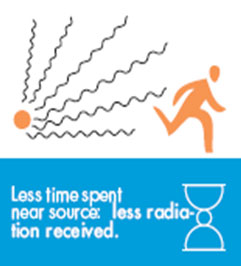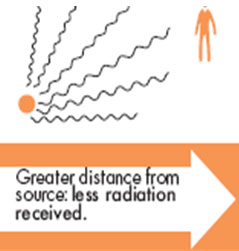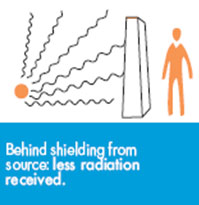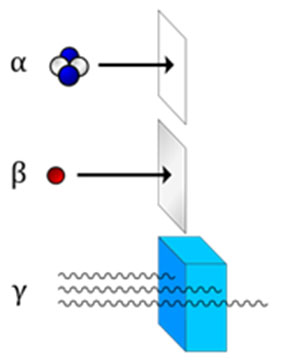Introduction
Ionizing radiation is radiation with enough kinetic energy so that during an interaction with an atom, it can remove tightly bound electrons from the orbit of an atom, causing the atom to become charged or ionized.
Such an event can alter chemical bonds and produce ions, that are especially chemically reactive. This greatly magnifies the chemical and biological damage per unit energy of radiation because chemical bonds will be broken in this process.
Depending on the level of exposure, radiation can pose a health risk. It can adversely affect individuals directly exposed as well as their descendants. Radiation can affect cells of the body, increasing the risk of cancer or harmful genetic mutations that can be passed on to future generations. If the dosage is large enough to cause massive tissue damage, it may lead to death within a few weeks of exposure.
Radiation protection, sometimes known as radiological protection, is the science and practice of protecting people and the environment from the harmful effects of ionizing radiation. Ionizing radiation is widely used in medicine and industry and can present a significant health hazard. It causes microscopic damage to living tissue, which can result in skin burns and radiation sickness at high exposure, and statistically elevates risk of cancer at low exposure.
Main Objective Of Radiation Protection
The objectives of radiation protection are to minimize the health effects due to radiation. Before formulating the appropriate countermeasures, we have to understand the biological effects of ionizing radiation.
Biological effects of radiation are mainly classified into “Deterministic Effect” and “Stochastic Effect”. For the former, a threshold value of absorbed dose exists, above which the radiation will bring detrimental effect to the health such as cataracts, skin erythema and sterility. For stochastic effect, a threshold does not exist, but the probability of having detrimental effect is proportional to the dose absorbed, such as cancer and genetic effect.
Based on the characteristics of the above biological effects, aims of radiation protection are to:
- prevent the deterministic effects by keeping doses below the relevant threshold; and
- reduce the probability of stochastic effects as much as is reasonably achievable
Principles of Radiation Protection
Any practice resulting in increased exposure to radiation should be carefully planned in accordance with the three basic radiological protection principles as set out by the Atomic Energy Licensing (Basic Safety Radiation Protection) Regulations 2010. These basic principles are:
-
Justification of practice – any practice involving exposure should be justifiable, i.e. it produces more benefit to the exposed individual or society than harm;
-
Optimisation of protection and safety – the magnitude of individual doses and the number of people exposed, except for therapeutic medical exposure, shall be kept as low as reasonably achievable, taking into account the economic and social factors; and
-
Individual dose limits – the exposure of individuals will be subjected to dose limits to ensure that no individual is exposed to radiation risks that are judged to be unacceptable.
Basic Concepts Of Radiation Protection

There are three factors that control the amount, or dose, of radiation received from a source. Radiation exposure can be managed by a combination of these factors:
- Time

The amount of radiation exposure increases and decreases with the time people or workers spend near the source of radiation. Reducing the time of an exposure reduces the dose proportionally. If the time spent in a given radiation field is doubled, the worker’s dose is doubled. Therefore, to limit radiation dose, the time spent in the field must be limited.
An example of reducing radiation dose by reducing the time of exposure might be improving operator training to reduce the time they take to handle a radiation source.
- Distance
The radiation dose received from a source is inversely proportional to the square of the distance of separation. As a rule, if you double the distance, you reduce the exposure by a factor of four. Distance can be as simple as handling a source with forceps rather than fingers.


Exposure at 2 meter
Exposure at 4 meterThe exposure of an individual sitting 4 meter from a radiation source will be 1/4 the exposure of an individual sitting 2 meter from the same source
- Shielding

The greater the shielding around a radiation source, the smaller the exposure. Shielding simply means having something that will absorb radiation between you and the source of the radiation. The radiation that manages to get through falls exponentially with the thickness of the shield. The amount of shielding required to protect is dependent on the different types of radiation and energy. 

Different types of radiation will require different kind of materials to shield it from getting through and causing exposure to the human? (Alpha) : A thin piece of light material, such as paper, or even the dead cells in the outer layer of human skin provides adequate shielding because alpha particles cannot penetrate it.
? (Beta) : Additional covering, for example heavy clothing, is necessary to protect against beta-emitters. Some beta particles can penetrate and burn the skin
? (Gamma): Thick, dense shielding, such as lead, is necessary to protect against gamma rays. The higher is the energy of the gamma ray, the thicker is the lead needed. X-rays pose a similar challenge, so radiographers often give patients receiving medical or dental X-rays a lead apron to cover other parts of their body.
Summary of The Radiation Protection Principles
- Practice that entails or that could entail exposure to radiation should only be adopted if it yields sufficient benefit to the exposed individuals or to society to outweigh the radiation detriment it causes or could cause;
-
Individual doses due to the combination of exposures from all relevant practices should not exceed specified dose limits;
-
Radiation sources and installations should be provided with the best available protection and safety measures under the prevailing circumstances, so that the magnitude and likelihood of exposures and the number of individuals exposed be as low as reasonably achievable, with economic and social factors being taken into consideration as well;
-
Radiation exposure due to sources of radiation that are not part of a practice should be reduced by intervention when this is justified, and the intervention measures should be optimized; the legal personnel authorized to engage in a practice involving a source of radiation should bear the primary responsibility for protection and safety;
-
Safety culture should be inculcated that governs the attitude and behavior in relation to protection and safety of all individuals and organizations dealing with sources of radiation;
-
Defensive in-depth measures should be incorporated into the design and operating procedures for radiation sources to compensate for potential failures in protection or safety measures; and
-
Protection and safety should be ensured by sound management and good engineering, quality assurance, training and qualification of personnel, comprehensive safety assessment and attention to lessons learned from experience and research.
Conclusion
The goal of radiation protection is to limit human exposure to ionizing radiation to a degree that is reasonable and acceptable in relation to the benefit gained from the activities that involved the exposure, thereby reducing the likelihood of occurrence of somatic and genetic effects.
In medical application exposure to ionizing radiation carries with it both a benefit and a risk. The benefit of information from an x-ray examination regarding the clinical management of the patient is weighed against the small, but nonetheless finite, risk when a physician requests the examination. The information on the clinical condition of a patient derived by the physician from a radiologic examination is an essential part of the practice of modern medicine.
It is the responsibility of the radiographer to ensure that each patient received the minimal dose of radiation that will produce a diagnostic image consistent with the requirement of the examination. Radiographers must also ensure that all individuals are properly protected from unnecessary radiation exposure.
References
- Atomic Energy Licensing (Basic Safety Radiation Protection) Regulations 2010
- International Commission on Radiological Protection (ICRP) Publication No. 60 (1991), Recommendations of the International Commission on Radiological Protection
- U.S. Environmental Protection Agency Web Site, http://www.epa.gov/rpdweb00/understand/protection_basics.html
- Richard R. Carlton & Arlene M. Adler; (2006), Principles of Radiographic Imaging- An Art and a Science 4th Edition. Thomson Delmar Learning
- WHO Website, http://www.who.int/ionizing_radiation/about/what_is_ir/en/ index.html
- Ismail Bahari & Mohd. Yusof Mohd Ali (Editor), Managing Radiation Safety – Guide for Radiation Protection Officers. Mc Graw Hill
| Last Reviewed | : | 9 January 2014 |
| Writer / Translator | : | Bazli b. Sapiin |
| Accreditor | : | Nik Mohamed Hazmi b. Nik Hussain |







